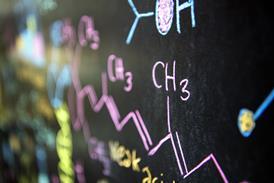All Organic chemistry articles – Page 13
-

-
 Feature
FeatureSymmetry of buckminsterfullerene
Both Euler's formula and Descartes' theorem can be used to show how buckyballs are made from closed cages of carbon pentagons and hexagons
-
 Feature
FeatureVincent van Gogh, chemistry and absinthe
The consumption of absinthe was once banned due to its reputation as a mysterious psychoactive drink. What does it contain? Was it responsible for the death of Van Gogh?
-
 Feature
FeatureTwo-step bromine attack
An experiment for the classroom to show that bromine adds to an alkene by two-step electrophilic addition
-

-
 The Mole
The MoleCitric acid
When you squeeze lemon juice over your pancakes this Shrove Tuesday, you will be using citric acid – 2-hydroxypropane-1,2,3-tricarboxylic acid. This molecule has a host of applications, making it quite a magnificent molecule
-

-

-

-

-

-
 Feature
FeatureJesuits' powder and quinine
The powdered bark of the South American cinchona tree is the source of quinine - the mainstay treatment for malaria for centuries
-
 Lesson plan
Lesson planDetermining the structure of compounds | 16–18 years
Examine data relating to the structure and complexity of compounds, including mass, infrared and 1H NMR spectra
-
 Lesson plan
Lesson planHow was the first artificial dye made? | 16-18 years
Explore organic synthesis and the making of the first artificial dye, mauve, in a lesson plan and directed activity related to text (DART) for 16–18 year olds.
-
 Lesson plan
Lesson planRules for naming hydrocarbons: alkanes to arenes | 16-18 years
Review the rules for naming hydrocarbon structures, including alkanes, alkenes, alkynes and arenes, using this lesson plan with activities for 16–18 year olds.
-
 Lesson plan
Lesson planNucleophilic substitution reaction mechanisms | 16-18 years
Help your students explore the mechanism for an organic nucleophilic substitution reaction using this lesson plan with activities for 16–18 year olds.
-

-
 Exhibition chemistry
Exhibition chemistryExplosive nitrated carbon compounds
Demonstrations designed to capture the student's imagination
-
 Feature
FeatureBelladonna, broomsticks and brain chemistry
Poisonous plants such as deadly nightshade produce toxic tropane alkaloids. These chemicals have been exploited in magic, murder and the design of a host of useful therapeutic drugs
-
 The Mole
The MoleSoap: can you make it with body fat and is there an explosive spin-off?
On screen chemistry with Jonathan Hare











